Making a nuclear chandelier for 100'000 lumen
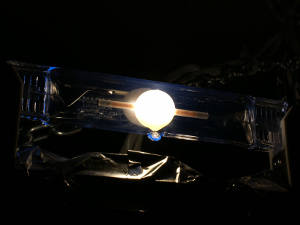 There is a stereotype that "IT" -shnik should sit in the twilight, illuminated only by the light of the monitor. I do not know about you, but I have always been more comfortable in bright light. At first it was 3x100W ordinary light bulbs, then 250W fluorescent bulbs, after the last move - one 500W halogen lamp ... But this was still not enough. I always wanted to have such lighting so that I would not want to make the light brighter. I will tell you about the creation of such a chandelier.
There is a stereotype that "IT" -shnik should sit in the twilight, illuminated only by the light of the monitor. I do not know about you, but I have always been more comfortable in bright light. At first it was 3x100W ordinary light bulbs, then 250W fluorescent bulbs, after the last move - one 500W halogen lamp ... But this was still not enough. I always wanted to have such lighting so that I would not want to make the light brighter. I will tell you about the creation of such a chandelier.Lamps
From my previous review of all types of lamps it is clear that I am not a big fan of LED lighting. Efficiency is limited, the spectrum is far from "sunny", the price is biting and serious problems with cooling. Therefore, I stopped at the metal halide OSRAM Powerball HCI-TS 150W / 942 NDL with a spherical ceramic burner - which gives us a spectrum close to the sun, a relatively modest price of lamps (880 rubles per unit, excluding electronic ballasts - electronic unit), service life more than 10 ' 000 hours and light output of 99 Lm / W (which significantly exceeds the fluorescent and LED (!) Lamps sold here).
Usually, metal halide lamps cannot be used without a closed lamp for two reasons: ultraviolet radiation and the possibility of a lamp burst. But these specific lamps have a built-in UV filter, and using electronic ballast the probability of an explosion is extremely low © (actually, as far as I know, all few cases of explosion of MGL lamps took place with magnetic ballasts, but more on that later)
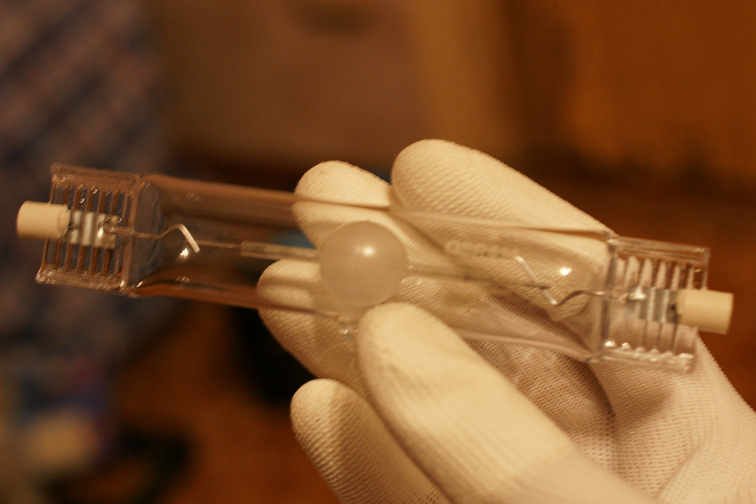
')
EPRU / ballast
Directly MGL lamps can not be included in 220 volts - they simply will not light up. And if they light up, then they need a lower voltage (and a stabilized current). To ignite the lamp - you need a pulse of up to 5000 volts. Electronic ballasts are often needed for this (often referred to as ballast, although ballast itself does not “ignite”, but only supports discharge).
Historically, before the ballasts were magnetic, with a blunt ignition system, which chisels the lamp with 5000V-pulses until it lights (or explodes). During operation - the efficiency of the magnetic ballast is also less. Modern electronic ballast - lights the lamp smoothly, giving out full power to the lamp only from the second minute (which prolongs its service life), and does not try to light the lamp indefinitely if something is wrong with it.
I chose OSRAM Powertronic PTi 150 ballast - you need one for each lamp. This model is because she is in a metal case.
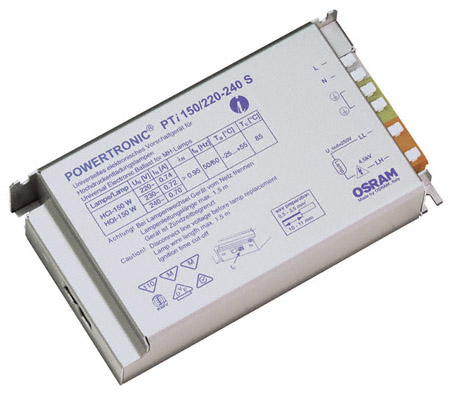
We collect
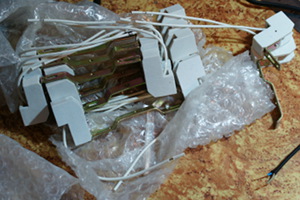 The biggest difficulty is to find fixtures for such lamps. The base is called R7s, ordinary halogen lamps are inserted into the same base. The problem is that 500W halogens have a length of 118mm, and these MGL lamps - 138mm, respectively, you need to look for either this deficient size ... or cut the existing ones and fasten the halves separately.
The biggest difficulty is to find fixtures for such lamps. The base is called R7s, ordinary halogen lamps are inserted into the same base. The problem is that 500W halogens have a length of 118mm, and these MGL lamps - 138mm, respectively, you need to look for either this deficient size ... or cut the existing ones and fasten the halves separately.All this is attached to the triangle of aluminum corners with bolts, and is suspended from the chain. Ballasts - peasant hanged on nylon ties. In order to spend less energy on heating the “chandelier” itself - the wires are laid as far as possible from the light, right under the lamp - a reflector made of aluminum adhesive tape.
Result and price of issue

Light - indescribable. I would call it “morning on a summer day”, warm and natural. The total light output is 99'400 lumens. What in my room gives a real illumination of about 2000 lux.
For comparison, 3x100W incandescent bulbs give 3600 lumens, 3x26 fluorescent bulbs give 4680 lumens. Thus, the lighting turned out to be about 20 times brighter than it usually happens in a room.
Price issue: Ballasts - 2000 * 7, lamps - 880 * 8 (one spare), chain, angles, bolts - <500 rubles. Total - about 22 thousand rubles.
A separate issue is electricity. At maximum power, all this happiness eats about 1150 watts (taking into account the ballast's efficiency), but we have a house on the electric stove + 3 wage meter, which gives a cost of about 500 rubles per month if the light is on 8 hours a day.
The result of half a year of use
For half a year, not a single light bulb burned out, although the difference in ignition speed between those that rarely and often burn is visible. At first, when turned on, there was a slight smell of ozone - I was puzzling my head for a long time. It turned out that one of the lamps was not tightly pressed to the contact in my sawn base, and the gap penetrated the spark during ignition.
Lamps - light up for 2 minutes, the first 10 seconds the light is very dim, and as it burns out, the color “floats”. After switching off - the lamps of 10 minutes do not turn on again, this is of course a minus, but it rarely interferes with me (mainly if the light in the whole house turns off for a few seconds). During the flare-up they noticeably buzz, after - quieter. But I certainly do not notice.
The therapeutic effect of bright light is also noticeable (light therapy usually begins with 2000 lux) - it is extremely difficult to get the blues in this light. Even if it is a placebo effect - it suits me completely.
Over time, however, with all 7 lamps it became uncomfortable, hurts the eyes, the guests complain. Because the last 4 months - I usually turn on only 3 of 7 lamps, and this is the most comfortable level of brightness for me.
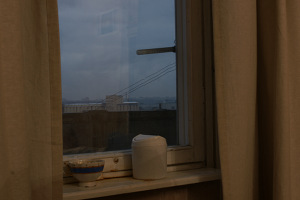 And finally - because this light is brighter and more pleasant than in the afternoon in winter on an overcast day, most of the winter there was no desire to see “natural”, cold, blue street light. On the right - you can see how the brightness of beige curtains is quite comparable with the brightness of the sky in overcast weather (13:30 in the afternoon). Well, when you go to another room, lit by ordinary lamps - I want to say “everybody get out of the gloom!” :-)
And finally - because this light is brighter and more pleasant than in the afternoon in winter on an overcast day, most of the winter there was no desire to see “natural”, cold, blue street light. On the right - you can see how the brightness of beige curtains is quite comparable with the brightness of the sky in overcast weather (13:30 in the afternoon). Well, when you go to another room, lit by ordinary lamps - I want to say “everybody get out of the gloom!” :-)In general, I have achieved my goal, and I am satisfied with the result: 99400 Lumen is too much for a room, 42,600 Lumen is the most comfortable level of illumination, 14,200 Lumen (one lamp) is quite sufficient.
Questions, comments?
Source: https://habr.com/ru/post/144514/
All Articles